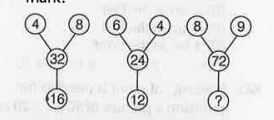51230701542(A)(B)(C)(D)(E)
Out of the following, which number will replace (D)?
230
84
46
106
The correct Answer is:D
To solve the problem, we need to identify the pattern in the first series of numbers (5, 12, 30, 70, 154) and then apply that pattern to the second series (2, (A), (B), (C), (D), (E)) to find the value of (D).
1. Identify the Pattern in the First Series:
- The first series is: 5, 12, 30, 70, 154.
- To find the relationship between the numbers, let's look at how we can go from one number to the next.
2. Calculate the Differences:
- From 5 to 12:
- Multiply 5 by 2 = 10, then add 2 → 10 + 2 = 12.
- From 12 to 30:
- Multiply 12 by 2 = 24, then add 6 → 24 + 6 = 30.
- From 30 to 70:
- Multiply 30 by 2 = 60, then add 10 → 60 + 10 = 70.
- From 70 to 154:
- Multiply 70 by 2 = 140, then add 14 → 140 + 14 = 154.
3. Identify the Adding Pattern:
- The numbers added are: 2, 6, 10, 14.
- The difference between these additions is consistently 4:
- 6 - 2 = 4
- 10 - 6 = 4
- 14 - 10 = 4
4. Establish the Pattern:
- The pattern is to multiply by 2 and then add an increasing sequence of numbers (2, 6, 10, 14) which increases by 4 each time.
5. Apply the Pattern to the Second Series:
- The second series starts with 2.
- We need to find (A), (B), (C), (D), and (E).
6. Calculate (A):
- Start with 2:
- Multiply 2 by 2 = 4, then add 2 → 4 + 2 = 6.
- So, (A) = 6.
7. Calculate (B):
- Start with 6:
- Multiply 6 by 2 = 12, then add 6 → 12 + 6 = 18.
- So, (B) = 18.
8. Calculate (C):
- Start with 18:
- Multiply 18 by 2 = 36, then add 10 → 36 + 10 = 46.
- So, (C) = 46.
9. Calculate (D):
- Start with 46:
- Multiply 46 by 2 = 92, then add 14 → 92 + 14 = 106.
- So, (D) = 106.
10. Final Answer:
- The value that will replace (D) is 106.
- The first series is: 5, 12, 30, 70, 154.
- To find the relationship between the numbers, let's look at how we can go from one number to the next.
- From 5 to 12:
- Multiply 5 by 2 = 10, then add 2 → 10 + 2 = 12.
- From 12 to 30:
- Multiply 12 by 2 = 24, then add 6 → 24 + 6 = 30.
- From 30 to 70:
- Multiply 30 by 2 = 60, then add 10 → 60 + 10 = 70.
- From 70 to 154:
- Multiply 70 by 2 = 140, then add 14 → 140 + 14 = 154.
- The numbers added are: 2, 6, 10, 14.
- The difference between these additions is consistently 4:
- 6 - 2 = 4
- 10 - 6 = 4
- 14 - 10 = 4
- The pattern is to multiply by 2 and then add an increasing sequence of numbers (2, 6, 10, 14) which increases by 4 each time.
- The second series starts with 2.
- We need to find (A), (B), (C), (D), and (E).
- Start with 2:
- Multiply 2 by 2 = 4, then add 2 → 4 + 2 = 6.
- So, (A) = 6.
- Start with 6:
- Multiply 6 by 2 = 12, then add 6 → 12 + 6 = 18.
- So, (B) = 18.
- Start with 18:
- Multiply 18 by 2 = 36, then add 10 → 36 + 10 = 46.
- So, (C) = 46.
- Start with 46:
- Multiply 46 by 2 = 92, then add 14 → 92 + 14 = 106.
- So, (D) = 106.
- The value that will replace (D) is 106.
Topper's Solved these Questions
- ADDITIONAL TOPICS IN MENTAL MATHBook:MCGROW HILL PUBLICATIONChapter:ADDITIONAL TOPICS IN MENTAL MATHExercise:EXERCISE 1
Explore 30 Videos
- ADDITIONAL TOPICS IN MENTAL MATHBook:MCGROW HILL PUBLICATIONChapter:ADDITIONAL TOPICS IN MENTAL MATHExercise:EXERCISE 2
Explore 25 Videos
- ALPHABET TESTBook:MCGROW HILL PUBLICATIONChapter:ALPHABET TESTExercise:EXERCISE
Explore 45 Videos
Similar Questions
Knowledge Check
1263915253(A)(B)(C)(D)(E)
Out of the following, which number will replace (B) ?A10B101C102D2231.51.52.254.511.254.5(A)(B)(C)(D)(E)
Out of the following, which number will replace (D)?A6.75B11.25C2.25D16.87531230661382827(a)(b)(c)(d)(e)
What will come in place of (b) ?A34B70C46DNone of these
3 20 118 587 2344 7027
12 A B C D E
Which number will come from the following at place of C ?
View SolutionReplace A,B,C,D by suitable numerals in the following
6AB5+D58C 9351
View Solution12301204601368271016(a)(b)(c)(d)(e)
What will come in place of (d) ?
View Solution154462231693346.51039.5276(a)(b)(c)(d)(e)
What will come in place of (b) ?
View SolutionIf a, b, c, d and e are positve numbers, and it is given that ,
a+b=c+db+d=2ad+e>a+bandc+d>a+e
then, which of the following statement is true ?
View Solution

